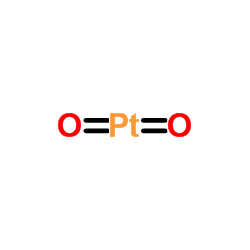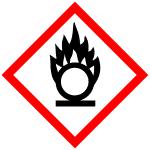Dioxoplatinum
Modify Date: 2024-01-02 11:08:03

Dioxoplatinum structure
|
Common Name | Dioxoplatinum | ||
|---|---|---|---|---|
| CAS Number | 52785-06-5 | Molecular Weight | 227.083 | |
| Density | 10.2 | Boiling Point | N/A | |
| Molecular Formula | O2Pt | Melting Point | 450 °C(lit.) | |
| MSDS | Chinese USA | Flash Point | N/A | |
| Symbol |


GHS03, GHS07 |
Signal Word | Danger | |
| Name | Platinum(IV) oxide hydrate |
|---|---|
| Synonym | More Synonyms |
| Density | 10.2 |
|---|---|
| Melting Point | 450 °C(lit.) |
| Molecular Formula | O2Pt |
| Molecular Weight | 227.083 |
| Exact Mass | 226.954636 |
| Water Solubility | INSOLUBLE |
|
SECTION 1: Identification of the substance/mixture and of the company/undertaking Product identifiers Product name: Platinum(IV) oxide hydrate REACH No.: A registration number is not available for this substance as the substance or its uses are exempted from registration, the annual tonnage does not require a registration or the registration is envisaged for a later registration deadline.
CAS-No.: 52785-06-5 Relevant identified uses of the substance or mixture and uses advised against Identified uses: Laboratory chemicals, Manufacture of substances SECTION 2: Hazards identification Classification of the substance or mixture Classification according to Regulation (EC) No 1272/2008 Oxidizing solids (Category 2), H272 Eye irritation (Category 2), H319 For the full text of the H-Statements mentioned in this Section, see Section 16. Classification according to EU Directives 67/548/EEC or 1999/45/EC O, Xi Oxidising, IrritantR 8, R36 For the full text of the R-phrases mentioned in this Section, see Section 16. Label elements Labelling according Regulation (EC) No 1272/2008 Pictogram Signal wordDanger Hazard statement(s) H272May intensify fire; oxidiser. H319Causes serious eye irritation. Precautionary statement(s) P220Keep/Store away from clothing/ combustible materials. P305 + P351 + P338IF IN EYES: Rinse cautiously with water for several minutes. Remove contact lenses, if present and easy to do. Continue rinsing. Supplemental Hazardnone Statements Other hazards - none SECTION 3: Composition/information on ingredients Substances Chemical characterization : Natural product Formula: O2Pt · xH2O Molecular Weight: 227,08 g/mol CAS-No.: 52785-06-5 EC-No.: 215-223-0 Hazardous ingredients according to Regulation (EC) No 1272/2008 ComponentClassificationConcentration Platinum dioxide CAS-No.52785-06-5Ox. Sol. 2; Eye Irrit. 2; H272,<= 100 % EC-No.215-223-0H319 Hazardous ingredients according to Directive 1999/45/EC ComponentClassificationConcentration Platinum dioxide CAS-No.52785-06-5O, Xi, R 8 - R36<= 100 % EC-No.215-223-0 For the full text of the H-Statements and R-Phrases mentioned in this Section, see Section 16 SECTION 4: First aid measures Description of first aid measures General advice Consult a physician. Show this safety data sheet to the doctor in attendance. If inhaled If breathed in, move person into fresh air. If not breathing, give artificial respiration. Consult a physician. In case of skin contact Wash off with soap and plenty of water. Consult a physician. In case of eye contact Rinse thoroughly with plenty of water for at least 15 minutes and consult a physician. If swallowed Never give anything by mouth to an unconscious person. Rinse mouth with water. Consult a physician. Most important symptoms and effects, both acute and delayed The most important known symptoms and effects are described in the labelling (see section 2.2) and/or in section 11 Indication of any immediate medical attention and special treatment needed no data available SECTION 5: Firefighting measures Extinguishing media Suitable extinguishing media Use water spray, alcohol-resistant foam, dry chemical or carbon dioxide. Special hazards arising from the substance or mixture no data available Advice for firefighters Wear self contained breathing apparatus for fire fighting if necessary. Further information Use water spray to cool unopened containers. SECTION 6: Accidental release measures Personal precautions, protective equipment and emergency procedures Use personal protective equipment. Avoid dust formation. Avoid breathing vapours, mist or gas. Ensure adequate ventilation. Evacuate personnel to safe areas. Avoid breathing dust. For personal protection see section 8. Environmental precautions Do not let product enter drains. Methods and materials for containment and cleaning up Sweep up and shovel. Contain spillage, and then collect with an electrically protected vacuum cleaner or by wet-brushing and place in container for disposal according to local regulations (see section 13). Keep in suitable, closed containers for disposal. Reference to other sections For disposal see section 13. SECTION 7: Handling and storage Precautions for safe handling Avoid contact with skin and eyes. Avoid formation of dust and aerosols. Provide appropriate exhaust ventilation at places where dust is formed.Keep away from sources of ignition - No smoking.Keep away from heat and sources of ignition.Normal measures for preventive fire protection. For precautions see section 2.2. Conditions for safe storage, including any incompatibilities Store in cool place. Keep container tightly closed in a dry and well-ventilated place. Specific end use(s) Apart from the uses mentioned in section 1.2 no other specific uses are stipulated SECTION 8: Exposure controls/personal protection Control parameters Components with workplace control parameters Exposure controls Appropriate engineering controls Handle in accordance with good industrial hygiene and safety practice. Wash hands before breaks and at the end of workday. Personal protective equipment Eye/face protection Safety glasses with side-shields conforming to EN166 Use equipment for eye protection tested and approved under appropriate government standards such as NIOSH (US) or EN 166(EU). Skin protection Handle with gloves. Gloves must be inspected prior to use. Use proper glove removal technique (without touching glove's outer surface) to avoid skin contact with this product. Dispose of contaminated gloves after use in accordance with applicable laws and good laboratory practices. Wash and dry hands. The selected protective gloves have to satisfy the specifications of EU Directive 89/686/EEC and the standard EN 374 derived from it. Full contact Material: Nitrile rubber Minimum layer thickness: 0,11 mm Break through time: 480 min Material tested:Dermatril® (KCL 740 / Z677272, Size M) Splash contact Material: Nitrile rubber Minimum layer thickness: 0,11 mm Break through time: 480 min Material tested:Dermatril® (KCL 740 / Z677272, Size M) data source: KCL GmbH, D-36124 Eichenzell, phone +49 (0)6659 87300, test method: EN374 If used in solution, or mixed with other substances, and under conditions which differ from EN 374, contact the supplier of the CE approved gloves. This recommendation is advisory only and must be evaluated by an industrial hygienist and safety officer familiar with the specific situation of anticipated use by our customers. It should not be construed as offering an approval for any specific use scenario. Body Protection impervious clothing, The type of protective equipment must be selected according to the concentration and amount of the dangerous substance at the specific workplace. Respiratory protection Where risk assessment shows air-purifying respirators are appropriate use a full-face particle respirator type N100 (US) or type P3 (EN 143) respirator cartridges as a backup to engineering controls. If the respirator is the sole means of protection, use a full-face supplied air respirator. Use respirators and components tested and approved under appropriate government standards such as NIOSH (US) or CEN (EU). Control of environmental exposure Do not let product enter drains. SECTION 9: Physical and chemical properties Information on basic physical and chemical properties a) AppearanceForm: powder Colour: dark brown b) Odourno data available c) Odour Thresholdno data available d) pH10,0 - 11,0 e) Melting point/freezingMelting point/range: 450 °C - lit. point f) Initial boiling point and no data available boiling range g) Flash pointnot applicable h) Evapouration rateno data available i) Flammability (solid, gas) no data available j) Upper/lowerno data available flammability or explosive limits k) Vapour pressureno data available l) Vapour densityno data available m) Relative densityno data available n) Water solubilityinsoluble o) Partition coefficient: n- no data available octanol/water p) Auto-ignitionno data available temperature q) Decompositionno data available temperature r) Viscosityno data available s) Explosive propertiesno data available t) Oxidizing propertiesThe substance or mixture is classified as oxidizing with the category 2. Other safety information no data available SECTION 10: Stability and reactivity Reactivity no data available Chemical stability Stable under recommended storage conditions. Possibility of hazardous reactions no data available Conditions to avoid no data available Incompatible materials Organic materials, Powdered metals Hazardous decomposition products In the event of fire: see section 5 SECTION 11: Toxicological information Information on toxicological effects Acute toxicity no data available Skin corrosion/irritation no data available Serious eye damage/eye irritation no data available Respiratory or skin sensitisation no data available Germ cell mutagenicity no data available Carcinogenicity IARC:No component of this product present at levels greater than or equal to 0.1% is identified as probable, possible or confirmed human carcinogen by IARC. Reproductive toxicity no data available Specific target organ toxicity - single exposure no data available Specific target organ toxicity - repeated exposure no data available Aspiration hazard no data available Additional Information RTECS: Not available To the best of our knowledge, the chemical, physical, and toxicological properties have not been thoroughly investigated. SECTION 12: Ecological information Toxicity no data available Persistence and degradability no data available Bioaccumulative potential no data available Mobility in soil no data available Results of PBT and vPvB assessment PBT/vPvB assessment not available as chemical safety assessment not required/not conducted Other adverse effects no data available SECTION 13: Disposal considerations Waste treatment methods Product Burn in a chemical incinerator equipped with an afterburner and scrubber but exert extra care in igniting as this material is highly flammable. Offer surplus and non-recyclable solutions to a licensed disposal company. Contact a licensed professional waste disposal service to dispose of this material. Contaminated packaging Dispose of as unused product. SECTION 14: Transport information UN number ADR/RID: 1479IMDG: 1479IATA: 1479 UN proper shipping name ADR/RID: OXIDIZING SOLID, N.O.S. (Platinum dioxide) IMDG: OXIDIZING SOLID, N.O.S. (Platinum dioxide) IATA:Oxidizing solid, n.o.s. (Platinum dioxide) Transport hazard class(es) ADR/RID: 5.1IMDG: 5.1IATA: 5.1 Packaging group ADR/RID: IIIMDG: IIIATA: II Environmental hazards ADR/RID: yesIMDG Marine pollutant: yesIATA: no Special precautions for user no data available SECTION 15 - REGULATORY INFORMATION N/A SECTION 16 - ADDITIONAL INFORMATION N/A |
| Symbol |


GHS03, GHS07 |
|---|---|
| Signal Word | Danger |
| Hazard Statements | H272-H319 |
| Precautionary Statements | P220-P305 + P351 + P338 |
| Personal Protective Equipment | Eyeshields;full-face particle respirator type N100 (US);Gloves;respirator cartridge type N100 (US);type P1 (EN143) respirator filter;type P3 (EN 143) respirator cartridges |
| Hazard Codes | O:Oxidizingagent;Xi:Irritant; |
| Risk Phrases | R38;R41;R8 |
| Safety Phrases | S26-S36/37/39-S28A-S22-S17 |
| RIDADR | UN 1479 5.1/PG 2 |
| WGK Germany | 2 |
| Packaging Group | II |
| Hazard Class | 5.1 |
|
Evans, D. A.; Mitch, C. H. et al.
J. Am. Chem. Soc. 102 , 5955, (1980)
|
|
|
Nishimoto, S.-I.; Ohtani, B. et al
J. Am. Chem. Soc. 105 , 7180, (1983)
|
|
|
Marino, J. P.; Fernandez de la Pradilla, R. et al.
J. Org. Chem. 52 , 4898, (1987)
|
| Platinum dioxide |
| Platinum, dioxo- |
| Dioxoplatinum |
| EINECS 215-223-0 |
| Platinum(IV) oxide |
| MFCD00066964 |

